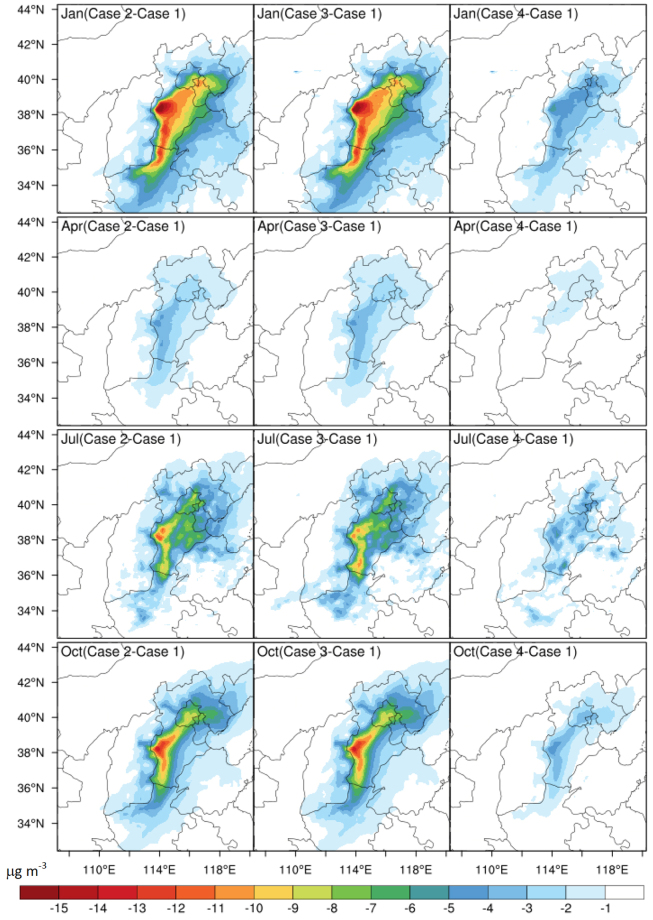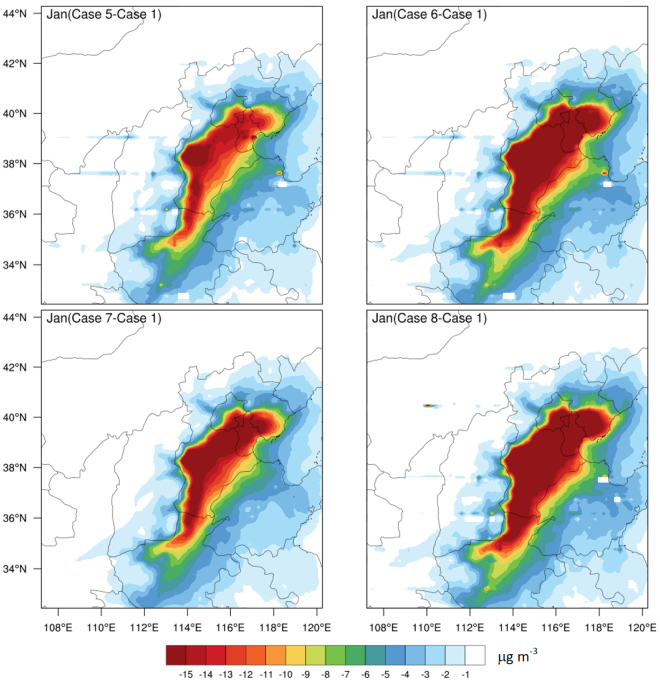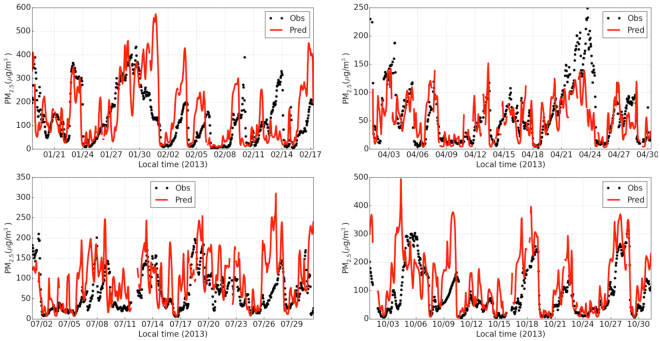Abstract
Widespread economic growth in China has led to increasing episodes of severe air pollution, especially in major urban areas. Thermal power plants represent a particularly important class of emissions. Here we present an evaluation of the predicted effectiveness of a series of recently proposed thermal power plant emission controls in the Beijing-Tianjin-Hebei (BTH) region on air quality over Beijing using the Community Multiscale Air Quality(CMAQ) atmospheric chemical transport model to predict CO, SO2, NO2, PM2.5, and PM10 levels. A baseline simulation of the hypothetical removal of all thermal power plants in the BTH region is predicted to lead to 38%, 23%, 23%, 24%, and 24% reductions in current annual mean levels of CO, SO2, NO2, PM2.5, and PM10 in Beijing, respectively. Similar percentage reductions are predicted in the major cities in the BTH region. Simulations of the air quality impact of six proposed thermal power plant emission reduction strategies over the BTH region provide an estimate of the potential improvement in air quality in the Beijing metropolitan area, as a function of the time of year.
Introduction
Among the 500 largest cities of China, it is estimated that fewer than 1% can meet World Health Organization air quality guidelines (10 µg m−3 for annual mean and 25 µg m−3 for 24-hour mean for fine particulate matter with aerodynamic diameter <2.5 µm(PM2.5)). Moreover, several of these cities are among the most polluted cities in the world1. In Beijing, the capital and economic, cultural, and political center of China, the number of so-called haze days (with visibility <10 km) has increased intensively since 20112. For example, in January 2013, 25 haze days were recorded, with two severe episodes occurring during 9–15 January and 25–31 January with maximum hourly PM2.5 mass concentrations of 680 and 530 µg−3, respectively3. Severe haze periods are characterized by intense secondary pollutant formation, stationary meteorological conditions, high relative humidity (RH), and low planetary boundary (PBL) depth4.
Of electric power capacity in China, 962 million KW in 2010, 80% was supplied by thermal power plants. Moreover, the thermal power plant sector in China is estimated to account for 31–59% of anthropogenic emissions of SO25–9, 21–44% of NOx10,11, and 9% of primary PM11. In Beijing, SO2, NOx, and PM10 attributed to thermal power plants are estimated to account for approximately 49%, 27%, and 11% of total emissions in the Beijing area, respectively. Specifically, emissions from coal burning have been estimated to account for ~26% of total PM2.5 sources during the January 2013 severe haze episodes in Beijing12. Here, we evaluate the potential effects of emission control policies for thermal power plants on air quality in Beijing.
Comprehensive 3-D air quality models (see Methods) have been used to evaluate the impacts of emission control strategies on local and regional air quality in China13–17. Wang et al.13 assessed the air quality improvement resulting from targeted SO2 and NOx emission controls for 2010; it was predicted that annual PM2.5 and SO2 could decline by 3–15 µg m−3 (4–25%) and 30–60%, respectively. Wang et al.16 predicted that for areas with PM2.5concentrations exceeding the second-level air quality standard (25 µg m−3 for annual mean and 50 µg m−3 for 24-hour mean) in 31 selected provinces in China, the annual mean SO2 and NOx concentrations in 2020 relative to 2010 could be reduced by 40.0% and 31.6%, respectively, and the annual mean PM2.5 concentration could decrease by 17.2%. Here we present results of the application of the CMAQ air quality model (see Methods) to evaluate the effects of thermal power generation emission controls in the Beijing-Tianjin-Hebei (BTH) region (Fig. 1).
Figure 1.
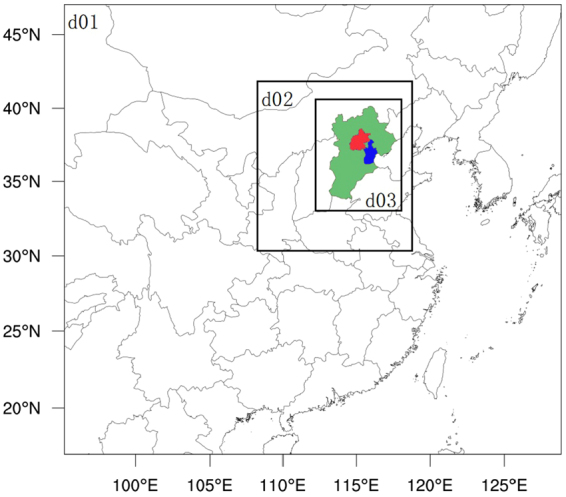
Triple nesting domains for computational implementation of the CMAQ model: d01 covers most of China and part of East Asia with the resolution of 36 × 36 km; d02 covers the Northern China Plain (NCP) with the resolution of 12 × 12 km; d03 covers the Beijing-Tianjin-Hebei (BTH) region with the resolution of 4× 4 km. Green, orange, and blue colors represent Heibei, Beijing, and Tianjin, respectively. The maps were created by NCAR Command Language (NCL) (http://www.ncl.ucar.edu/).
Emission Control Scenarios
Table 1 lists the emission controls corresponding to a range of policies for thermal power plants in the BTH region. All thermal power plants in the BTH region use coal as the only fuel. These include the policy A “Emission standard of air pollutants of thermal power plants (GB13223-2011)” (released on July 29, 2011) and policy B “Action Plan for the Transformation and Upgrading of Coal Power Energy Conservation and Emission Reduction (2014–2020)” (released by the Chinese government on September 12, 2014) (http://www.sdpc.gov.cn/gzdt/201409/t20140919_626240.html). The eight emission scenarios in Table 1 will be evaluated here for thermal power plants in the BTH region. Since the policy A was carried out on January 1, 2013, it is assumed that the baseline scenario, Case 1, was implemented as of that date. Case 1 therefore serves as a basis: (1) to simulate current air quality in the BTH region for the base year; (2) to evaluate model performance; and (3) to determine the effectiveness of other potential policies to improve air quality in Beijing. According to policy A, key areas such as the BTH region need to conform to special emission limits. Key areas are defined as those with high land development density, weakened atmospheric carrying capacity, and fragile ecological environment. In Case 2 for special emission limits, the emission standards for SO2, smoke dust, and PM2.5 as listed in Table 1 are changed to 50, 20, and 10 mg m−3, respectively.
Table 1.
Emission control standards of different cases for thermal power plants in the BTH region.
| Scenario Cases | Description | Emission Standards (mg m−3) | |||
|---|---|---|---|---|---|
| SO2 | NO2 | Smoke Dust | PM2.5 | ||
| 1a | Baseline scenario A | 200 | 100 | 30 | 15 |
| 2a | Special emission limits | 50 | 100 | 20 | 10 |
| 3b | Ultra-low emissions B | 35 | 50 | 10 | 8 |
| 4 | Adjustment of structures | 200 | 100 | 30 | 15 |
| 5c | Extremely ultra-low emissions | 35 | 50 | 5 | 4 |
| 6c | “Near zero” emissions | 15 | 25 | 1 | 0.8 |
| 7c | Green power generation | 20 | 30 | 4.5 | 4 |
| 8 | No thermal power plant emissions | 0 | 0 | 0 | 0 |
aSee http://kjs.mep.gov.cn/hjbhbz/bzwb/dqhjbh/dqgdwrywrwpfbz/201109/W020130125407916122018.pdf.
bSee http://www.zhb.gov.cn/gkml/hbb/gwy/201409/t20140925_289556.htm.
cCases 5, 6, 7 are carried out only for the month of January over the domain d02 with the grid resolution 12 km.
According to the policy B, all thermal power units must meet ultra-low emission standards. In Case 3, emission standards of SO2, NO2, smoke dust, and PM2.5 are 70%, 50%, 50%, and 80% of those of Case 2, respectively. Policy B includes acceleration of the upgrade of active thermal power units, especially for those <200 MW. Figure 2 shows the distribution and percentage of the thermal power plants in terms of unit capacities in the three areas for the BTH region in 2013 (http://ieimodel.org/jjjdqhdhypfqd). Units with capacity <200 MW and >600 MW account for 64% and 7% of the total units, respectively (Fig. 2B), while the unit capacity is mainly located in Tianjin, Shijiazhuang, Tangshan, and Handan, especially in the southwest and east of the BTH region (Fig. 3A and B). In Case 4, all units with output <200 MW are assumed to be eliminated to evaluate the extent to which this structural adjustment would affect Beijing air quality.
Figure 2.
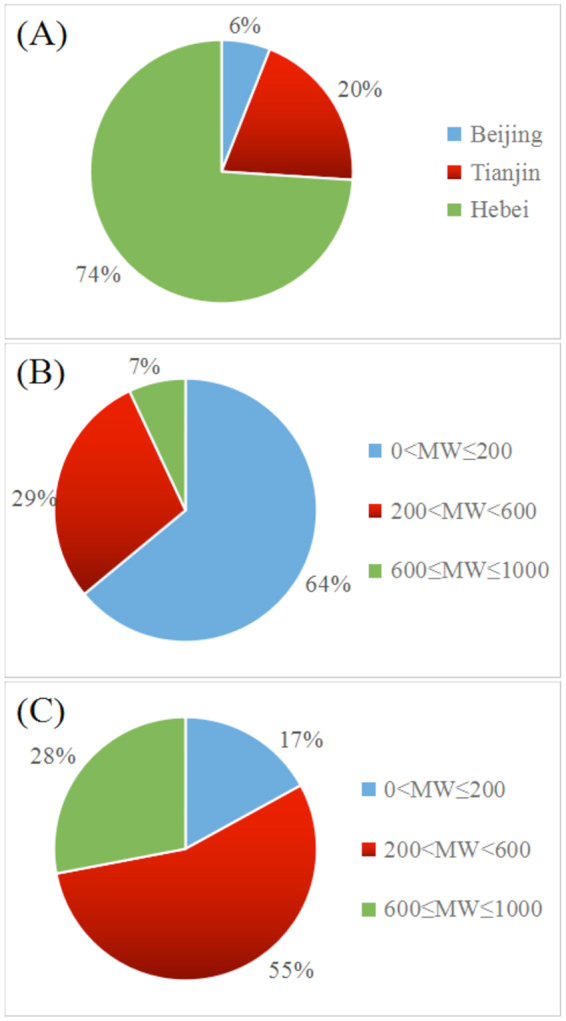
Proportional distributions of thermal power plants in the BTH region in 2013 based on (A) unit capacity for the three areas, (B) the distribution of units by MW capacity, and (C) the unit capacity for the entire region.
Figure 3.
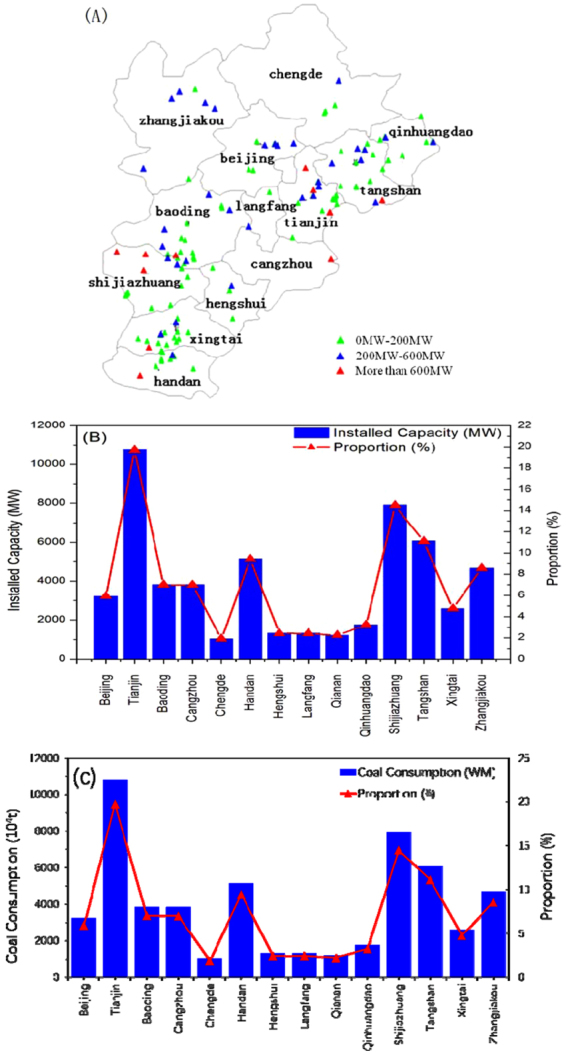
BTH region. (A) Locations of thermal power plants; (B) total capacity of thermal power plants and their distribution by city; (C) coal consumption distribution in the BTH region in 2013. The maps were created by NCAR Command Language (NCL) (http://www.ncl.ucar.edu/).
The Shenhua Group Corporation Ltd. proposed three emission control policies including “Extremely ultra-low” (Case 5), “Near zero” (Case 6), and “Green power generation” (Case 7) (http://www.shenhuagroup.com.cn/shjtww/1382682123426/201506/cc7d7362c2224378ab536a27aa30b8b7.shtml). The Shenhua Group is the largest coal supplier in the world. In Case 5, the emission standards for smoke dust and PM2.5 are set to be one-half, but remain unchanged for SO2 and NO2, relative to Case 3. In Case 6, emission standards of SO2, NO2, smoke dust, and PM2.5 are set at 40%, 50%, 20%, and 20% of those of Case 5, respectively. In Case 7,emission standards for SO2, NO2, smoke dust, and PM2.5 lie between those of Cases 5 and 6. Case 8 represents the hypothetical total absence of thermal power plants in the BTH region. Since air quality in Beijing is poorest in the winter, simulations for Cases 5, 6, and 7 are carried out only for the month of January over the domain d02 with the grid resolution of 12 km (Fig. 1).
Predicted influence of emission control policies on Beijing air quality
Monthly mean concentrations of PM2.5, PM10, NO2, CO, and SO2 for different emission scenarios at 12 monitoring stations in the Beijing are used as a basis to assess the predicted improvement in Beijing air quality associated with the emission control policies relative to those of the baseline emission control scenario (Case 1). Table 2 summarizes the predicted annual percentage reductions in Cases 2, 3, 4 relative to Case 1 (CO, SO2, NO2, PM2.5, and PM10), while Table 3 shows the percentage reductions for Cases 5, 6, 7 in January, and Table 4 shows the percent reductions for total removal of power plants. Spatial distributions of the reduction of PM2.5 for January, April, July, and October are shown in Fig. 4, while Fig. 5 shows the spatial distributions of predicted monthly mean reductions for PM2.5 for implementation of Cases 5, 6, 7 relative to that of Case 1. Cases 2 and 3 lead to higher reduction percentages than Case 4 for all species except CO, for which all three emission control policies predict similar reduction percentages (Table 2). Predicted monthly mean reductions in Beijing in January for Cases 5, 6, 7 for PM2.5 range from 9.05% to 12.12% (Table 3). The spatial distributions of predicted reduction of PM2.5 in different months for Cases 2, 3, 4, shown in Fig. 4, indicate that the largest percent reduction of PM2.5 would occur in January, especially in Tianjin and over the central part of Hebei (southwest of Beijing), for Cases 2 and 3. This response is consistent with the dominant locations of the coal-fired power plants (Fig. 3A).
Table 2.
Predicted annual percentage reductions and amounts* (in parentheses) of Cases 2, 3, and 4 relative to Case 1 in Beijing with a resolution of 4 × 4 km.
| Species | |||
|---|---|---|---|
| CO | −20.65 (−0.39) | –20.42 (–0.38) | –20.41 (–0.38) |
| SO2 | −7.37 (−3.23) | −7.30 (−3.20) | −3.13 (−1.37) |
| NO2 | −7.81 (−3.93) | −7.47 (−3.76) | −3.49 (−1.75) |
| PM2.5 | –6.31 (−6.59) | −6.18 (−6.45) | −2.63 (−2.75) |
| PM10 | −5.94 (−6.90) | −5.82 (−6.76) | −2.61 (−3.03) |
*Units of CO are mg m−3 and those of other species are µg m−3.
Table 3.
Predicted percentage reductions and amounts* (in parentheses) corresponding to Cases 5, 6, and 7 relative to Case 1 in January in Beijing.
| Species | |||
|---|---|---|---|
| CO | −22.98 (−0.60) | −27.73 (−0.73) | −23.26 (−0.61) |
| SO2 | −9.21 (−4.51) | −14.82 (−7.26) | −13.66 (−6.68) |
| NO2 | −8.89 (−5.70) | −11.10 (−7.11) | −9.29 (−5.95) |
| PM2.5 | −9.05 (−13.76) | −12.12 (−18.43) | −10.17 (−15.46) |
| PM10 | −8.62 (−13.87) | −11.75 (−18.71) | −10.61 (−17.07) |
*Units of CO are mg m−3 and those of other species are µg m−3.
Table 4.
Percent contributions of thermal power plant emissions in the BTH region to atmospheric species in Beijing based on assumed total removal of power plants (Case 8).
| Species | CO | SO2 | NO2 | PM2.5 | PM10 |
|---|---|---|---|---|---|
| Jan | −39.42 | −23.55 | −22.02 | −27.07 | −26.59 |
| Apr | −34.12 | −22.20 | −22.99 | −21.03 | −21.82 |
| Jul | −35.16 | −23.43 | −21.63 | −22.19 | −20.97 |
| Oct | −38.73 | −22.97 | −24.73 | −22.16 | −24.16 |
| Annual | −37.63 | −23.09 | −23.02 | −23.78 | −24.04 |
Figure 4.
Distribution of PM2.5 reduction amount (µg m−3) in January, April, July, and October for Cases 2, 3, and 4 relative to the base Case 1 on the basis of the simulations with grid resolution of 12 km. The maps were created by NCAR Command Language (NCL) (http://www.ncl.ucar.edu/).
Figure 5.
Distribution of predicted monthly mean reductions of PM2.5 (µg m−3) for Cases 5, 6, 7, and 8 relative to that of Case 1 in January 2013. The maps were created by NCAR Command Language (NCL) (http://www.ncl.ucar.edu/).
To meet increasingly stringent emission standards and obtain maximum emission reductions from the coal-fired power plants, “Extremely ultra-low” (Case 5), “Near zero” (Case 6), and “Green power generation” (Case 7) policies have been proposed. Emission levels from coal-fired power plants adopting these newly-designed emission control technologies are comparable with those from natural gas-fired plants. Table 3 summarizes predicted reduction percentages and amounts of PM2.5, PM10, NO2, CO, and SO2 in Beijing in January for these cases. Spatial distributions of PM2.5 reduction amounts over the BTH region in Fig. 5 show that most of PM2.5 reduction amounts are located in the southeast Beijing, Tianjin and the central Hebei with the largest reductions from Cases 6 (“Near zero emission”) and 8 (“No thermal power plants”) and lowest reductions from Case 5 (“Extremely ultra-low”), being consistent with the emission control standards (Table 1) and domain locations of the coal-fired power plants (Fig. 3A), as expected.
Predicted SO2 reduction percentages for the newly-designed emission control policies (Cases 5, 6, 7) are predicted to range from −9.2% to −14.8%, exceeding those of the current emission control policies (ranging from −2.7% to −6.0%). As expected, among these emission policies, Case 6 (“Near zero emission”) leads to the largest reduction percentages for all species (PM2.5, PM10, NO2, CO, and SO2) (Table 3), consistent with the emission control standards in Table 1. For Case 8 “No thermal power plants” in Table 4, the predicted annual contributions of thermal power plants over the BTH region to the concentrations of CO, SO2, NO2, PM2.5, and PM10 in Beijing are 37.6%, 23.1%, 23.0%, 23.8% and 24.0%, respectively. Thermal power plants over the BTH region are predicted to contribute appreciably to CO concentrations in Beijing (Table 4). The lowest values in Beijing contributed by thermal power plants over the BTH region are predicted to occur in April for CO, SO2, and PM2.5, whereas in July for NO2 and PM10.
In comparison with the prediction of the current emission control policies (Cases 2, 3 and 4) in Table S2, Cases 5, 6 and 7 lead to further modest reductions of PM2.5, PM10, NO2, CO and SO2 in Beijing (see Table S3). For example, the reduction percentages for PM2.5 for the newly-designed emission control policies lie between −9.1% and −12.1%, about 10% to 7% higher than those of the current emission control policies (range from −2.0% to −5.1%) in January Predictions for PM10 are close to those for PM2.5. CO reduction percentages for the newly-designed emission control policies range from −23.0% and −27.7%, about 3% to 7% higher than those of the current emission control policies (range from −20.4% to −20.8%), and for SO2, reduction percentages for the newly-designed emission control policies range from −9.2% and −14.8%, about 6% to 12% higher than those of the current emission control policies (range from −2.7% to −6.0%). As expected, among these newly-designed emission policies, Case 6 (“Near zero emission”) predicts the largest reduction percentages for all species (PM2.5, PM10, NO2,CO and SO2), followed by Cases 7 and 5 (see Table S3), consistent with the emission control standards in Table 1. The results in Tables S2 and S3 suggest that the extent to which it is worth carrying out these newly-designed emission control policies depends on their economics.
Tables S10–S21 (Supplemental Information) summarize predicted annual PM2.5, CO, SO2, NO2, and PM10 reduction percentages in 12 other major Chinese cities (Tianjin, Baoding, Cangzhou, Chengde, Handan, Hengshui, Qinhuangdao, Shijiazhuang, Tangshan, Xingtai, Zhangjiakou, Langfang) over the BTH region for Cases 2, 3, 4 on the basis of simulations at the 12 km grid resolution. The annual mean predicted reduction percentages for PM2.5 are between −4.5% and −10.7%, with the highest value in Zhangjiakou and the lowest value in Hengshui for Cases 2 and 3, while they lie between −1.7% and −3.4% for Case 4. Predicted reduction percentages for Case 3 are slightly higher than those of Case 2 for all species (CO, SO2, NO2, PM2.5, and PM10) for all cities except Tianjin. Predicted monthly mean reduction amounts in January are the highest for CO, SO2, NO2, PM2.5, and PM10 for all three emission control policies, as expected.
Conclusions
Thermal power plants (entirely coal-burning) are a major source of atmospheric emissions in China, controls on which are crucial for the improvement of air quality. In this work, we assess the potential air quality benefits in Beijing from different thermal power emission control policies for the BTH region. Predicted annual mean reduction percentages in Beijing lie between −5.3% and −6.3% for PM2.5, PM10, NO2, and SO2 for Cases 2 (“Special emissions limits”) and 3 (“Ultra-low emission standards”), and between −2.2% and −3.0% for Case 4 (“Adjustment of structures”), reflecting the effects of eliminating all units <200 MW. All three emission control policies are predicted to lead to similar reduction percentages between −18.9% and −20.7% for CO. In comparison with current emission control policies, the newly-designed control policies considered here are predicted to lead to reductions in January levels in Beijing between −8.6% and −14.8% for PM2.5, PM10, NO2, and SO2 and between −23.0% and −27.7% for CO. Predictions for Case 8 (“No thermal power plants”) in the BTH region suggest that the annual mean contributions of thermal power plants to the concentrations of CO, SO2, NO2, PM2.5, and PM10 in Beijing are 37.6%, 23.1%, 23.0%, 23.8%, and 24.0%, respectively, with the highest values occurring in January for all species except NO2. Predictions for the other 12 major cities over the BTH region for these emission control policies exhibit similar responses to those in Beijing.
Methods
Emission inventory
Anthropogenic emissions of SO2, NOx, CO, NMVOC, NH3, PM10 and PM2.5 over China are based on the Multi-resolution Emission Inventory for China (MEIC)9 for 2012 (www.meicmodel.org), while those for the rest of the domain were estimated on the basis of Emissions Database for Global Atmospheric Research (EDGAR): HTAP V2 (0.1° × 0.1°). Multi-resolution Emission Inventory for China (MEIC) is a dynamic technology-based inventory for more than 700 anthropogenic emitting sources developed for China covering the years from 1990 to 2013 by Tsinghua University following the work of INTEX-B9. With the detailed source classification by representing emission characteristics of different sectors, fuels, products, emission control and combustion/process technologies, the MEIC model can derive emissions which were aggregated to five sectors: power plants, industries, residential, transportation, and agriculture9. For example, transportation emissions at high spatial resolution were derived on the basis of vehicle population and emission factors, while the emissions at high-resolution model grids can be derived on the basis of a digital road map and weighting factors of kilometers traveled and road types9. The lumped speciated NMVOC emissions were derived for each source sector by allocating the total NMVOC emissions according to the speciation assignment approaches for different chemical mechanisms such as CB05 in the MEIC. Temporal variations and gridded emissions were created for each sector using different temporal profiles and spatial aggregations.
In this work, power plant emissions in the BTH region generated by the Appraisal Center for Environment and Engineering in the State Environmental Protection Ministry of China (http://ieimodel.org/jjjdqhdhypfqd) were used to replace those in the MEIC emission inventory. These new power plant emissions in the BTH region were derived on the basis of the power plant emission data information from CEMS (Continuous Emission Monitoring System) measurements, Environmental Impact Assessment (EIA) measurements and follow-up inspection for the power plants in China (http://ieimodel.org/jjjdqhdhypfqd). Power plant emissions were estimated for each thermal power plant unit on the basis of fuel consumption rates, fuel quality, combustion technology and emission control technology.
Model description
This study employs the Weather Research and Forecast (WRF, version 3.4)17 model coupled with Community Multiscale Air Quality (CMAQ, version 5.0) model18–22. We use a nested grid configuration with an outer grid encompassing most of China and part of eastern Asia (36 km grid resolution), the first inner grid encompassing the North China Plain (12 km grid resolution) and the second inner grid covering the BTH region (4 km grid resolution) (Fig. 1). The physics package of the WRF3.4 (ARW) includes version 2 of the Kain-Fritsch cumulus cloud parameterization (KF2)23, Morrison et al. two-moment cloud microphysics24–26, the Asymmetric Convective Model version 2 (ACM2) for the planetary boundary layer (PBL)27,28, the RRTMG radiation mechanism and the Pleim-Xiu land-surface model29,30, with indirect soil moisture and temperature nudging31,32. The aerosol module of the CMAQ model is AERO6, and the gas-phase chemical mechanism is CB05. Boundary conditions for the inner domains are derived from simulations of the outer domains and the meteorological initial, and lateral boundary conditions for the outermost domain were derived from the National Center for Environmental Prediction (NCEP) final analysis dataset with a spatial resolution of 1° × 1° and a temporal resolution of 6 h. The default chemical boundary conditions (BCONs) in the CMAQ model were used in the simulations for the outermost domain of base year 2013. The WRF-CMAQ model simulation periods include January, April, July, and October in 2013 to represent winter, spring, summer, and autumn seasons, respectively.
Model performance for PM2.5, PM10, NO2, SO2, and CO
To evaluate model performance, the mean bias (MB), normalized MB (NMB) and root mean square error (RSME), normalized mean error (NME) and correlation coefficient (r) are calculated33. Monthly and annual results of model performance evaluation for PM2.5, PM10, NO2, CO, and SO2 in Beijing are summarized in Table S1 (see Supplemental Information) for the baseline emission scenario (Case 1) at the grid resolution of 12 km. Figure 6 shows the time-series comparisons of the observed and predicted hourly mean PM2.5 concentrations in Beijing for each month at the grid resolution of 12 km. Model performance for PM2.5, PM10, NO2, CO, and SO2 in Beijing is similar for the simulations at grid resolutions of 36, 12, and 4 km (see Supplemental Information). For example, the NMB values for PM2.5 are 19.6%, 26.6%, and 23.2% at 36 km, 12 km, and 4 km grid resolutions, respectively, on the basis of the annual simulations, while the corresponding NMB values for PM10 are 3.6%, 10.9%, and 8.1%, respectively.
Figure 6.
Time-series comparisons of the observed (Obs) and predicted (Pred) hourly mean PM2.5 concentrations in Beijing for January-February, April, July, and October 2013.
Simulations at all three grid resolutions for SO2, CO, and PM2.5 exhibit poorer performance for July and October as compared with that for January and April (see Supplemental Information). Model simulations at all three grid resolutions (4 × 4, 12 × 12, 36 × 36 km) exhibit good performance for NO2 for all months except July. Significant overestimation of SO2in July is likely a result of non-representative locations and elevations of surface observation sites34, where SO2 is primarily emitted from stacks above local shallow inversion layers, while measurement stations are located close to the surface. Time-series comparisons of observed and predicted PM2.5 for different months in Beijing (Fig. 6) indicate that the predictions capture the hourly variations and broad synoptic changes in the observed PM2.5 concentrations.
Hourly observed concentrations (PM2.5, PM10, NO2, CO, and SO2) at 12 monitoring stations in Beijing obtained from the website “China’s air quality on-line monitoring analysis platform (http://www.aqistudy.cn/)” were used for evaluating the two-way coupled WRF-CMAQ model. The 12 Beijing monitoring stations include Wanshouxigong (38.87°N, 116.37°E), Changpingzhen (40.20°N, 116.23°E), Nongzhanguan (39.97°N, 116.47°E), Tiantan (39.87°N, 116.43°E), Guanyuan (39.94°N, 116.36°E), Haidianquwanliu (39.99°N, 116.32°E), Dongsi (39.95°N, 116.43°E), Gucheng (39.93°N, 116.23°E), Shunyixincheng (40.14°N, 116.72°E), and Aotizhongxin (40.00°N, 116.41°E). Since observational data before 18:00 January 17, 2013 are unavailable, the period from January 18 to February 17 of 2013 was used to represent January 2013. To evaluate model performance, concurrent hourly predicted concentrations at the monitoring sites were averaged in parallel with the hourly observations.
Electronic supplementary material
Acknowledgements
This work was supported in part by the Department of Science and Technology of China (Nos 2016YFC0202702; 2014BAC22B06) and the National Natural Science Foundation of China (No. 221577126). This work was supported by the Joint NSFC-ISF Research Program (No. 41561144004), jointly funded by the National Natural Science Foundation of China and the Israel Science Foundation. The work was also supported in part by the “Zhejiang 1000 Talent Plan” and Research Center for Air Pollution and Health in Zhejiang University. We also thank Dr. Hua Mo from Appraisal Center for Environment & Engineering in Ministry of Environmental Protection of China for providing the power plant emissions in the BTH region.
Author Contributions
S.Y. and J.H.S. initiated the project and designed the experiments; S.Y., P.L., L.W., and J.H.S. wrote the main manuscript. S.Y., L.W., P.L., S.C., K.M., Z.L., W.L., D.R., R.C.F., and J.H.S. contributed to the interpretation and to manuscript preparation.
Competing Interests
The authors declare that they have no competing interests.
Footnotes
Liqiang Wang and Pengfei Li contributed equally to this work.
Electronic supplementary material
Supplementary information accompanies this paper at 10.1038/s41598-018-19481-0.
Publisher's note: Springer Nature remains neutral with regard to jurisdictional claims in published maps and institutional affiliations.
Contributor Information
Shaocai Yu, Email: shaocaiyu@zju.edu.cn.
John H. Seinfeld, Email: seinfeld@caltech.edu
References
- 1.Zhang, Q. & Crooks, R. Toward an environmentally sustainable future: country environmental analysis of the People’s Republic of China. (Asian Development Bank, 2012).
- 2.Liu XG, et al. Formation and evolution mechanism of regional haze: a case study in the megacity Beijing, China. Atmos. Chem. Phys. 2013;13:4501–4514. doi: 10.5194/acp-13-4501-2013. [DOI] [Google Scholar]
- 3.Wang J, et al. Impact of aerosol-meteorology interactions on fine particle pollution during China’s severe haze episode in January 2013. Environ. Res. Lett. 2014;9:094002. doi: 10.1088/1748-9326/9/9/094002. [DOI] [Google Scholar]
- 4.Yang YR, et al. Characteristics and formation mechanism of continuous extreme hazes in China: a case study in autumn of 2014 in the North China Plain. Atmos. Chem. Phys. 2015;15:10987–11029. doi: 10.5194/acpd-15-10987-2015. [DOI] [Google Scholar]
- 5.Streets, D. G. et al. An inventory of gaseous and primary aerosol emissions in Asia in the year 2000. J. Geophys. Res. 108, GTE 30–31 (2003).
- 6.Ohara T, et al. An Asian emission inventory of anthropogenic emission sources for the period 1980–2020. Atmos. Chem. Phys. 2007;7:6483–6902. doi: 10.5194/acp-7-4419-2007. [DOI] [Google Scholar]
- 7.Cofala J, Amann M, Klimont Z, Kupiainen K, Höglund-Isaksson L. Scenarios of global anthropogenic emissions of air pollutants and methane until 2030. Atmos. Environ. 2007;41:8486–8499. doi: 10.1016/j.atmosenv.2007.07.010. [DOI] [Google Scholar]
- 8.Zhao Y, et al. Primary air pollutant emissions of coal-fired power plants in China: current status and future prediction. Atmos. Environ. 2008;42:8442–8452. doi: 10.1016/j.atmosenv.2008.08.021. [DOI] [Google Scholar]
- 9.Li M, et al. MIX: A mosaic Asian anthropogenic emission inventory under the international collaboration framework of the MICS-Asia and HTAP. Atmos. Chem. Phys. 2017;17:935–963. doi: 10.5194/acp-17-935-2017. [DOI] [Google Scholar]
- 10.Hao J, Tian H, Lu Y. Emission inventories of NOx from commercial energy consumption in China, 1995–1998. Environ. Sci. Technol. 2002;36:552–560. doi: 10.1021/es015601k. [DOI] [PubMed] [Google Scholar]
- 11.Zhang Q, et al. NOx emission trends for China, 1995-2004: the view from the ground and the view from space. J. Geophys. Res. 2007;112:D22306. doi: 10.1029/2007JD008684. [DOI] [Google Scholar]
- 12.Huang RJ, et al. High secondary aerosol contribution to particulate pollution during haze events in China. Nature5. 2014;14:218–222. doi: 10.1038/nature13774. [DOI] [PubMed] [Google Scholar]
- 13.Wang L, et al. Assessment of air quality benefits from national air pollution control policies in China. Part I: Background, emission scenarios and evaluation of meteorological predictions. Atmos. Environ. 2010;44:3442–3448. doi: 10.1016/j.atmosenv.2010.05.051. [DOI] [Google Scholar]
- 14.Wei XL, Li YS, Lam KS, Wang AY, Wang TJ. Impact of biogenic VOC emissions on a tropical cyclone-related episode in the Pearl River Delta region, China. Atmos. Environ. 2007;41:7851–7864. doi: 10.1016/j.atmosenv.2007.06.012. [DOI] [Google Scholar]
- 15.Cheng Z, et al. Impact of biomass burning on haze pollution in the Yangtze River delta, China: a case study in summer 2011. Atmos. Chem. Phys. 2014;14:4573–4585. doi: 10.5194/acp-14-4573-2014. [DOI] [Google Scholar]
- 16.Wang Z, et al. Assessment of air quality benefits from the national pollution control policy of thermal power plants in China: a numerical simulation. Atmos. Environ. 2015;106:288–304. doi: 10.1016/j.atmosenv.2015.01.022. [DOI] [Google Scholar]
- 17.Skamarock WC, Klemp JB. A time-split nonhydrostatic atmospheric model for weather research and forecasting applications. J. Comput. Phys. 2008;227:3465–3485. doi: 10.1016/j.jcp.2007.01.037. [DOI] [Google Scholar]
- 18.Eder BK, Yu S. A performance evaluation of the 2004 release of Models-3 CMAQ. Atmos. Environ. 2006;40:4811–4824. doi: 10.1016/j.atmosenv.2005.08.045. [DOI] [Google Scholar]
- 19.Pleim, J. et al. Two-Way Coupled Meteorology and Air Quality Modeling. Air Pollution Modeling and Its Application XIX (eds Borrego, C. & Miranda, A. I.) 496–504 (Springer, 2008).
- 20.Eder B, et al. A Performance evaluation of the National Air Quality Forecast Capability for the summer of 2007. Atmos. Environ. 2009;43:2312–2320. doi: 10.1016/j.atmosenv.2009.01.033. [DOI] [Google Scholar]
- 21.Wong DC, et al. WRF-CMAQ two-way coupled system with aerosol feedback: software development and preliminary results. Geosci. Model. Dev. 2012;5:299–312. doi: 10.5194/gmd-5-299-2012. [DOI] [Google Scholar]
- 22.Yu S, et al. Aerosol indirect effect on the grid-scale clouds in the two-way coupled WRF-CMAQ: model description, development, evaluation and regional analysis. Atmos. Chem. Phys. 2013;13:25649–25739. doi: 10.5194/acpd-13-25649-2013. [DOI] [Google Scholar]
- 23.Kain JS. The Kain Fritsch convective parameterization: an update. J. Appl. Meteorol. 2004;43:170–181. doi: 10.1175/1520-0450(2004)043<0170:TKCPAU>2.0.CO;2. [DOI] [Google Scholar]
- 24.Morrison H, Thompson G, Tatarskii V. Impact of cloud microphysics on the development of trailing stratiform precipitation in a simulated squall line: comparison of one- and two-moment schemes. Mon. Weather Rev. 2011;137:991–1007. doi: 10.1175/2008MWR2556.1. [DOI] [Google Scholar]
- 25.Morrison H, Curry JA, Khvorostyanov VI. A new double-moment microphysics parameterization for application in cloud and climate models. Part I: description. J. Atmos. Sci. 2005;62:1665–1677. [Google Scholar]
- 26.Morrison H, Pinto JO. Intercomparison of bulk cloud microphysics schemes in mesoscale simulations of springtime Arctic mixed-phase stratiform clouds. Mon. Weather Rev. 2006;134:1880–1900. doi: 10.1175/MWR3154.1. [DOI] [Google Scholar]
- 27.Pleim JE. A combined local and nonlocal closure model for the atmospheric boundary layer. Part I: model description and testing. J. Appl. Meteorol. Climatol. 2007;46:1383–1395. doi: 10.1175/JAM2539.1. [DOI] [Google Scholar]
- 28.Pleim JE. A combined local and nonlocal closure model for the atmospheric boundary layer. Part II: application and evaluation in a mesoscale meteorological model. J. Appl. Meteorol. Climatol. 2007;46:1396–1409. doi: 10.1175/JAM2534.1. [DOI] [Google Scholar]
- 29.Pleim JE, Xiu A. Development and testing of a surface flux and planetary boundary layer model for application in mesoscale models. J. Appl. Meteorol. 1995;34:16–32. doi: 10.1175/1520-0450-34.1.16. [DOI] [Google Scholar]
- 30.Xiu A, Pleim JE. Development of a land surface model. Part I: application in a mesoscale meteorology model. J. Appl. Meteorol. 2001;40:192–209. doi: 10.1175/1520-0450(2001)040<0192:DOALSM>2.0.CO;2. [DOI] [Google Scholar]
- 31.Pleim JE, Xiu A. Development of a land surface model. Part II: data assimilation. J. Appl. Meteorol. 2003;42:1811–1822. doi: 10.1175/1520-0450(2003)042<1811:DOALSM>2.0.CO;2. [DOI] [Google Scholar]
- 32.Pleim JE, Gilliam R. An indirect data assimilation scheme for deep soil temperature in the Pleim-Xiu land surface model. J. Appl. Meteorol. Climatol. 2009;48:1362–1376. doi: 10.1175/2009JAMC2053.1. [DOI] [Google Scholar]
- 33.Yu S, Eder B, Dennis R, Chu SH, Schwartz SE. New unbiased symmetric metrics for evaluation of air quality models. Atmos. Sci. Lett. 2006;7:26–34. doi: 10.1002/asl.125. [DOI] [Google Scholar]
- 34.Yu S, et al. Performance and diagnostic evaluation of ozone predictions by the Eta-Community Multiscale Air Quality Forecast System during the 2002 New England Air Quality Study. J. Air & Waste Manage. Assoc. 2006;56:1459–1471. doi: 10.1080/10473289.2006.10464554. [DOI] [PubMed] [Google Scholar]
Associated Data
This section collects any data citations, data availability statements, or supplementary materials included in this article.



